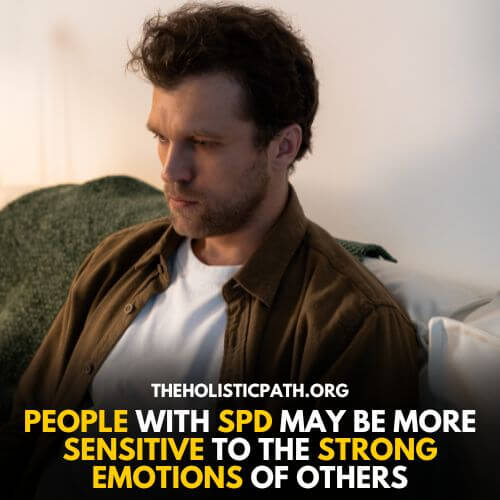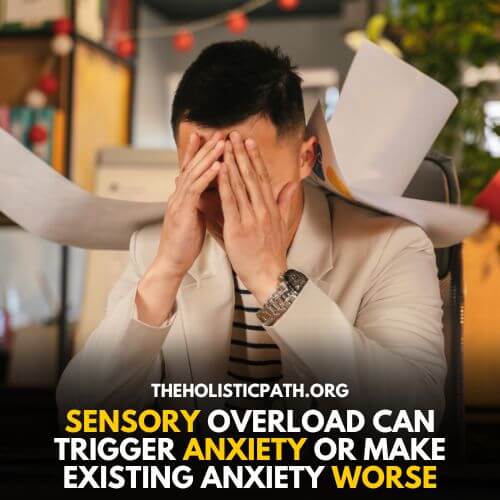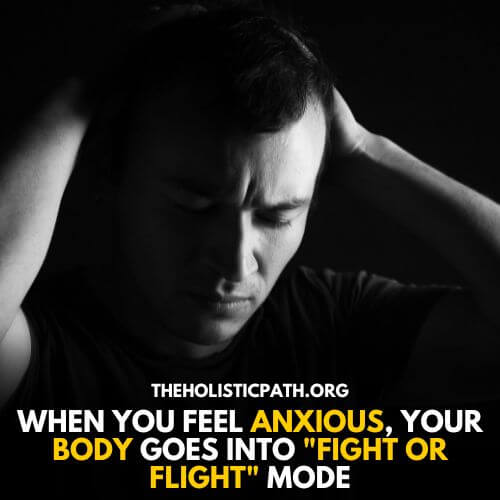When most people think of anxiety, they think of mental health disorders. But did you know that there’s also such a thing as physical anxiety? Sensory Processing Disorder (SPD) is a condition where the brain has trouble processing information from the senses.
This can lead to a feeling of overwhelming anxiety and can be very debilitating. People with SPD often feel like they’re in “fight or flight” mode all the time, which can lead to panic attacks and other problems. So, in this article, we’ll explore sensory processing disorder and anxiety.
There is no cure for SPD, but there are treatments that can help manage the symptoms. If you think you might have SPD, talk to your doctor about getting a diagnosis and finding a treatment plan that works for you.
5 Patterns of Sensory Processing Disorder In Adults
Sensory Processing Disorder (SPD) is a neurological disorder that affects the way the brain processes information from the senses. People with SPD can be oversensitive to certain stimuli, making everyday activities such as eating, drinking, or wearing clothes painful or uncomfortable.
They may also be undersensitive to stimuli, meaning they have trouble processing information and may not be aware of their surroundings. SPD can vary in severity, and people with the disorder may exhibit one or more of the following patterns:
- Tactile defensiveness: oversensitivity to touch, often resulting in avoidance of activities that involve physical contact such as hugging or being touched. People with tactile defensiveness may also have difficulty tolerating certain fabrics or textures.
- Oral defensiveness: oversensitivity to taste and texture, often resulting in avoidance of certain foods or food groups. People with oral defensiveness may also have difficulty tolerating toothpaste, mouthwash, or other orally-applied products.
- Auditory hypersensitivity: oversensitivity to sound, often resulting in avoidance of loud noise or sudden changes in noise level. People with auditory hypersensitivity may also have difficulty tolerating certain types of music or sounds.
- Vestibular dysfunction: problems with balance and coordination, often resulting in dizziness or nausea. People with vestibular dysfunction may also have difficulty staying still or keeping their heads still.
- Proprioceptive dysfunction: problems with body awareness, often resulting in clumsiness or poor coordination. People with proprioceptive dysfunction may also have difficulty knowing where their limbs are in space or judging how much force is necessary to perform an action.
5 Strong ways Sensory Processing Disorder Affects Emotions
Sensory processing disorder (SPD) is a condition that can cause difficulty regulating the body’s response to sensory input. This can lead to challenges with emotions, as well as physical and behavioral difficulties.
There are five main ways that SPD can affect emotions:
1. Difficulty Interpreting Facial Expressions and Nonverbal Cues
People with SPD may have trouble understanding the emotions of others, due to difficulties interpreting facial expressions and nonverbal cues. This can make social interactions more challenging and may lead to feelings of isolation or loneliness.
2. Difficulty Modulating Arousal Levels
People with SPD may have difficulty regulating their own arousal levels in response to sensory input. This can lead to feeling overwhelmed or easily agitated in certain situations.
3. Sensitivity to Strong Emotions
People with SPD may be more sensitive to the strong emotions of others, such as anger or fear. This can amplify the emotional impact of the situation and make it more difficult to cope.
4. Emotional Outbursts
Due to the challenges associated with regulating emotions, people with SPD may occasionally experience emotional outbursts that are disproportionate to the situation. This can be disruptive and cause further difficulties in social interactions.
5. Difficulty Recognizing Emotions
People with SPD may have difficulty recognizing their own emotions, due to the way that sensory input is processed by the brain. This can lead to feeling disconnected from oneself and others and may contribute to problems with self-regulation.

6 Powerful Ways How Is Sensory Processing Disorder And Anxiety Are Linked
Most people are familiar with the concept of anxiety, but fewer people are familiar with sensory processing disorder (SPD). However, the two conditions are actually quite closely linked. Here are six ways in which SPD and anxiety are connected:
- Sensory processing disorder occurs when the brain has difficulty processing information from the senses. This can lead to a feeling of being overwhelmed or out of control.
- People with SPD often have a low threshold for sensory input. This means that they are easily overloaded by noise, touch, or other stimuli.
- Sensory processing disorder can also cause difficulties with motor skills and coordination. This can lead to feelings of clumsiness or insecurity.
- People with SPD often avoid certain activities or situations due to their fear of being overloaded by sensory stimuli. This can result in social isolation and anxiety.
- Children with SPD are often misdiagnosed as having ADHD or autism due to their difficulties with focus and concentration. However, research has shown that children with SPD are just as likely to have anxiety as those with ADHD or autism.
- Finally, people with SPD are at an increased risk of developing anxiety disorders in adulthood. One study found that adults with SPD were four times more likely to develop an anxiety disorder than those without SPD.
Sensory processing disorder and anxiety are clearly closely linked. If you or someone you know has SPD, it is important to be aware of the potential for developing anxiety and to seek treatment if necessary.
Link Between Auditory Processing Disorder And Anxiety
Auditory processing disorder (APD) is a condition that affects the way the brain interprets sound. People with APD have difficulty understanding speech, particularly when there is background noise. This can make everyday activities, such as talking on the phone or listening to a lecture, very difficult.
Anxiety is a common comorbidity of APD in adults. A study by Groen et al. found that 38% of adults with APD also had an anxiety disorder. That number is significantly higher than the general population, where only 18% of adults have an anxiety disorder.
The researchers concluded that anxiety and APD share many risk factors, such as family history and exposure to early life stressors. They also found that anxiety can worsen the symptoms of APD, making everyday activities even more difficult.
There are many ways to treat both anxiety and APD. Cognitive behavioral therapy (CBT) is an effective treatment for both conditions. CBT can help people with APD to retrain their brains to better process sound, and it can also help people with anxiety to manage their fear and worry.
Medication may also be necessary to treat either condition. If you think you or someone you know may have APD or anxiety, talk to a doctor or mental health professional about treatment options.
6 Mental Conditions Associated With Sensory Overload
Anyone who has ever felt overwhelmed by a loud noise, intense light, or strong smell can attest to the fact that sensory overload is very real and can be extremely unpleasant. For some people, however, sensory overload is a chronic condition that can have a profound impact on their day-to-day lives.
Here are six mental conditions that are often associated with sensory overload:
- Anxiety: Sensory overload can trigger anxiety or make existing anxiety worse. Symptoms may include a racing heart, sweating, and dizziness.
- Depression: Sensory overload can worsen depression or lead to new episodes of depression. Symptoms may include feeling hopeless, helpless, or worthless.
- OCD: People with OCD may be especially sensitive to sensory input and may have difficulty tolerating even small amounts of stimulation. Symptoms may include repetitive behaviors such as hand-washing or counting.
- ADHD: People with ADHD may be more susceptible to sensory overload than others. They may struggle to focus and pay attention and be easily distracted by noise and other stimuli.
- PTSD: Sensory overload can trigger flashbacks and other symptoms in people with PTSD. Symptoms may include anxiety, depression, and intrusive thoughts or memories.
- Autism Spectrum Disorder: Individuals on the autism spectrum often experience sensory processing difficulties, which can lead to problems with regulating emotions and interacting with others.

5 Strong Sensory Overload Anxiety Symptoms In Adults
When we experience anxiety, it can sometimes feel like our senses are on overdrive. This is known as sensory overload, and it can be a hugely overwhelming experience.
Symptoms of sensory overload can vary from person to person, but there are some common ones that are worth being aware of.
- Elevated heart rate: When you feel anxious, your body goes into “fight or flight” mode. This causes an elevation in heart rate as your body prepares to respond to a perceived threat.
- Sweating: Sweating is another physical response that occurs when you are anxious. This is due to the release of adrenalin in your body as part of the “fight or flight” response.
- Dry mouth: Dry mouth is a common symptom of anxiety, and can be caused by both the physical response of increased adrenaline production and the psychological response of fear or worry.
- Shortness of breath: Anxiety can cause you to take shallower and faster breaths, which can lead to feelings of shortness of breath.
- Muscle tension: Anxiety can cause muscle tension, as your body prepares for a possible physical altercation (even if there is no real threat). You may notice tension in your shoulders, neck, and back, as well as in your jaw (if you clench your teeth when you’re anxious).

Sensory Processing Disorder And Anxiety Panic Attack
Sensory Processing Disorder (SPD) is a condition that can impact people of all ages and from all walks of life. Though exact numbers are difficult to come by, it is estimated that SPD affects approximately 1 in 20 people.
While the condition can present in a variety of ways, one of the most common symptoms is a heightened sense of anxiety or panic. In fact, research has shown that there are a number of links between SPD and anxiety or panic attacks.
For example, people with SPD often have difficulty processing and filtering sensory input. This can lead to feeling overwhelmed by stimuli such as sound, sight, or touch.
This in turn can trigger an anxious response or a panic attack. Additionally, people with SPD often have trouble regulating their emotions. This means that they may be more likely to experience anxiety or panic in response to stressful situations.
People with SPD may also be more prone to avoidance behaviors. This may involve avoiding certain places or activities that trigger anxiety or panic attacks. In some cases, this avoidance can become so severe that it leads to agoraphobia (a fear of public places).
Finally, people with SPD often have difficulty sleeping. This can lead to feelings of fatigue and further exacerbate anxiety and panic symptoms.
While the exact cause of SPD is unknown, it is thought to be related to both genetic and environmental factors. If you suspect that you or someone you know may have SPD, it is important to seek professional help.
With proper diagnosis and treatment, it is possible to manage the symptoms of SPD and live a healthy and enjoyable life.
6 Effective Tips To Treat Sensory Overload Anxiety
People with sensory overload anxiety often feel like they are constantly bombarded with too much stimulation. This can lead to feelings of overwhelm, anxiety, and even panic.
If you are struggling with this type of anxiety, here are six tips that may help:
- Identify your triggers: What situations or activities tend to trigger your anxiety? Once you know what your triggers are, you can try to avoid them or be prepared for them ahead of time.
- Limit your exposure to stimuli: If you know you will be in a situation that is likely to cause sensory overload, try to limit your exposure to stimulating activities beforehand. For example, if you know you will be attending a loud concert, wear earplugs and take breaks as needed.
- Use relaxation techniques: Deep breathing, progressive muscle relaxation, and mindfulness meditation can all help to lessen anxiety and bring about a sense of calm.
- Create a safe space: Designate a space in your home that is peaceful and calming. This can be a place where you can go to relax and unwind when you are feeling overwhelmed.
- Seek professional help: If your anxiety is becoming too much to handle on your own, consider seeking help from a therapist or counselor who specializes in treating anxiety disorders.
- Be patient with yourself: Recovery from anxiety takes time. Remember that there will be good days and bad days, but eventually, things will get better.
Conclusion
In conclusion, Sensory Processing Disorder can cause a great deal of anxiety for those affected by it. While there is no cure, there are treatments available that can help lessen the symptoms and allow sufferers to lead more normal lives.
If you think you or someone you know may have SPD, please contact a qualified medical professional for diagnosis and treatment options. With proper care, those with SPD can learn to cope with their condition and lead happy, fulfilling lives.
Frequently Asked Questions
What is Sensory Processing Disorder (SPD)?
Sensory Processing Disorder (SPD) is a neurological disorder that affects the way individuals process and responds to sensory information from their environment.
People with SPD experience difficulties in interpreting sensory input, which can lead to issues with motor coordination, social interaction, and behavior. The disorder is most commonly seen in children but may also be experienced by adults.
Common signs of SPD include difficulty filtering out background noise, avoiding certain textures or fabrics, being overly sensitive to smells or tastes, and exhibiting extreme reactions to unexpected loud noises or sudden movements.
Others include appearing clumsy or uncoordinated due to poor body awareness and having difficulty engaging in activities that require sustained focus and attention.
How is Anxiety related to Sensory Processing Disorder?
Anxiety can be a direct result of SPD since people with this condition are often overwhelmed by everyday sensory experiences due to their heightened sensitivity to touch, sound, smell, taste, light, or movement.
As such, these individuals may become highly anxious in situations where they are exposed to unexpected or unfamiliar sensations that don’t follow the same patterns as what they are used to experiencing.
Additionally, those living with SPD may feel helpless when trying to understand why certain sensations cause them distress which can further contribute to anxiety-related symptoms such as panic attacks and difficulty sleeping.
Can anxiety trigger sensory overload?
Yes, anxiety can trigger sensory overload. When we become anxious, our bodies go into fight-or-flight mode, which means that all of our senses become heightened and focus on the potential threats or stressors in our environment.
This leads to an overstimulation of sensory information that can be difficult for those with anxiety to process. As a result, they may experience sensory overload, where their senses become overloaded with too much information.
This can lead to feelings of confusion and overwhelm, which can make it even more difficult for them to process the sensory information in their environment.
Additionally, some people may also be sensitive to specific sounds or environments that may trigger sensory overload as well.
How do you calm someone with sensory issues?
1. Stay Calm: It can be difficult to remain calm in the face of someone else’s anxiety and distress, but it’s important to practice self-care and stay as composed as possible.
2. Create a Safe Place: Help the person find a safe place away from any potential triggers such as loud noises or bright lights. Make sure they are as comfortable as possible and offer to stay with them if they would like company.
3. Provide Distractions: Offer distraction techniques such as squeezing a stress ball or listening to music. Ask the person what helps them when they experience anxiety or sensory overload and use those strategies at the moment.
4. Encourage Self-Regulation: Help the person practice deep breathing, progressive muscle relaxation, or other calming strategies. Remind them to focus on their breath and notice the sensations in their body that come with each inhalation and exhalation.
5. Seek Professional Advice: If the person’s sensory issues become too difficult to manage, seek advice from a mental health professional. They can help determine what strategies will work best for the individual. Additionally, they can provide additional resources and support to help them cope with their anxiety or sensory issues.
How is Sensory Processing Disorder treated?
The primary treatment for SPD focuses on helping an individual learn how to effectively self-regulate their responses when exposed to certain stimuli including different sounds, textures, smells, and lights.
A range of therapies such as occupational therapy and physical activity can help individuals develop their sense of body awareness while providing them with strategies for managing everyday tasks more easily and safely.
For those who experience severe anxiety-related symptoms as a result of their SPD diagnosis, it may also be necessary for them to receive psychological counseling in order for them to better manage their emotions and thoughts on an ongoing basis.
References:
Kibby McMahon, Deepika Anand, Marissa Morris-Jones, and M. Zachary Rosenthal. (July 9, 2019). A Path From Childhood Sensory Processing Disorder to Anxiety Disorders: The Mediating Role of Emotion Dysregulation and Adult Sensory Processing Disorder Symptoms. https://www.ncbi.nlm.nih.gov/pmc/articles/PMC6629761/
Matti Cervin ( September 23, 2022). Sensory Processing Difficulties in Children and Adolescents with Obsessive-Compulsive and Anxiety Disorders. https://link.springer.com/article/10.1007/s10802-022-00962-w
Nava Levit‐binnun ( November 20, 2020). The relationship between sensory responsiveness profiles, attachment orientations, and anxiety symptoms. https://www.tandfonline.com/doi/full/10.1111/ajpy.12064
